 |
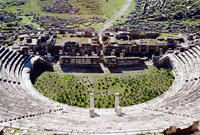 |
|
THE THEATER
Was a small Hellenistic theater with a seating capacity of 5,300, but in the beginning of the 2C AD it was modified to a Roman theater and held about 15,000 people. The lower section was built onto a natural hillside, and the upper is supported by vaulted substructures up to a height of 40 m / 131 ft. |
|
| The facade facing the harbor is 140 m / 460 ft long. During the Roman period the stage building had three stories and was 34 m / 111 ft wide. In front of the stage building it is still possible to see pieces depicting hunting scenes of Eros. |
|
| BYZANTINE FORTRESS
Is located at the top of the theater hill was which is thought to have been built mostly with the stones of the theater in the 7C AD but restored later by the Seljuks. |
|
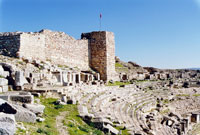 |
|
 |
|
HARBOR MONUMENTS
Stood in front of the Lions' Harbor. There were two of them; different in size but similar in style. The large piece was 7.5 m / 25 ft high, mounted on a three-cornered base built on a round foundation with a diameter of 11 m / 36 ft. The smaller one was only 5.3 m / 17.5 ft. |
|
| THE DELPHINIUM
Was a Hellenistic open air shrine surrounded by stoas on four sides with a 6C BC altar in the center. Together with Apollo, the dolphin was sacred for the Milesians as they believed that when the first settlers sailed they were guided by god in the form of a dolphin. The annual festival and celebrations of Didyma were started here. |
|
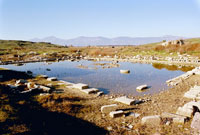 |
|
| An Ionic Stoa lay parallel to the processional road on the south of the Delphinium. It is a 1C AD structure which had 35 Ionic columns and 19 shops behind the columns. |
|
 |
|
THE BOULETERION
Was a 2C BC building which consisted of a propylon, a courtyard and an auditorium had three Corinthian columns and friezes depicting war scenes. It opened into a courtyard with a monumental tomb in the middle. There were four gates that opened into the main hall, seated 1,500 people and had a wooden roof. |
|
| THE NYMPHAEUM
Was first built in the 2C AD and rebuilt in the following century. It faced the bouleterion across the processional road and had three stories with statues of gods placed in niches and water spouting from the mouths of bronze fish. |
|
 |
|
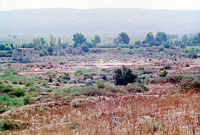 |
|
THE SOUTH AGORA
Lay behind the bouleterion. It was a Hellenistic structure which was later remodeled in the Roman period. Today the North Gate is unfortunately another of the gems from Anatolia currently housed in the Pergamum Museum in Berlin. The South Gate was 180 m by 150 m (196 yards by 164 yards) and destroyed during the construction of Ilyas Bey Mosque. |
|
| THE TEMPLE OF SERAPIS
Lay between the south agora and the Faustina baths. It consisted of a pronaos and a naos with Corinthian columns and a relief of Serapis on the pediment. The temple was a 3C BC building which was rebuilt in the 3C AD with a donation by Emperor Julius Aurelius. |
|
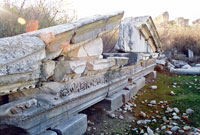 |
|
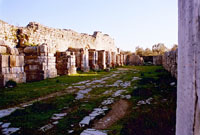 |
|
THE BATHS OF FAUSTINA
Were 2C AD Roman baths which were built by Faustina, Marcus Aurelius's wife who usually accompanied her husband on his journeys through the Empire. The frigidarium had a reclining statue of the river god probably personifying the Meander River. |
|
| THE IONIC STOA
The stoa, lying on north-south axis to the east of the Sacred Way, had 35 Ionic columns in front and 19 shops at the rear. The backs of the shops were bounded by the Hellenistic gymnasium and the palaestra of the Vergilius Capito Baths. The stoa, situated at a higher level than the Sacred Way, was reached by steps. |
|
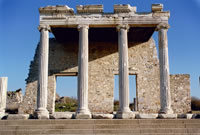 |
|
| The northern part of it was destroyed due to the bath constructed during the Menteseogullari period. The stoa was, on the evidence of inscriptions, built in 50 AD by Tiberius Claudius Sophanes. |
|
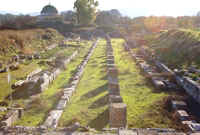 |
|
STOREHOUSE
Built in Hellenistic period according to the remains, it was used as a granary. It was used for the same purpose in the Roman period with certain changes. A row of columns running along the middle of the two-winged buildings, carried the roof. Column bases stood on angular and high stone blocks. |
|
| The tore house believed to be connected to the South Agora by a door and a tunnel-like passage on the east side. A great latrine was built between the storehouse and the South Agora in the Roman period, of which the only remains today are water closet holes and baked clay pipes. |
|
|
 |
|
|
|